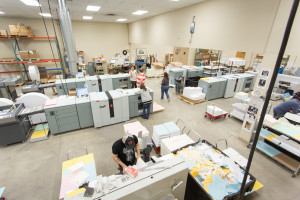A “perfector,” in printer’s parlance, is a printing press capable of printing both sides of the sheet in one pass. For book printers, this is important both for efficiency and quality. All books print both sides of the sheet, so a perfector is twice as fast as a one-sided press where the sheets have to be flipped and run back through the press. Also, front-to-back alignment of the “type page” (the area that is actually printed on the page) is a key element of high-quality book printing. Perfectors allow for fine-tuning this alignment.
For digital book printers, unfortunately, most black-and-white digital presses are not perfectors: they perform fancy loop-de-loops to flip the paper over and run it back through the imaging path to print the second side. This makes highly accurate front-to-back alignment a chancy thing—something a lot of printing companies don’t even attempt to achieve when printing digitally. Here at Bookmobile, we used to spend hours every day running tests, adjusting alignment, rerunning, and adjusting to ensure that the front-to-back alignment falls within our stringent quality specs. Hours spent testing and tweaking are hours when we are not printing books. We hate hours when we are not printing books.
With the acquisition of our new Océ VarioPrint 6320s, that has all changed.
Océ is a company based in the Netherlands and founded in 1877 to make colorants for butter and margarine. The grandson of the founder became interested in printing technology, and in 1919, he launched a better process for making the blueprints used by architects and engineers. Since then, Océ has innovated in other areas of printing, one of them being toner-based printing—that is, the kind of printing used in toner-based laser printers, copiers, and machines like the Xerox Docutech series. Most toner-based digital printers use powerful static charges to transfer the fine toner particles to the areas on a drum that you want to print; the drum then transfers the image to the paper, and 400-degree fuser elements melt the toner onto the paper. Océ’s Copy Press technology uses lower-temperature 195-degree elements to preheat the paper, and pressure to press the toner into it. The benefits are less heating which means less paper curl, a crisper image, less toner dust flying around, and fewer paper jams. However, Copy Press printers have had a bad rap for producing gray rather than black in the darkest areas.
We first saw the Varioprint 6250, the first machine in the line that includes our 6320s, when it was introduced at Graphexpo in 2006. The Varioprint used Océ’s Copy Press technology. We had smaller Océ printers in the ’90s, so we were aware of the Copy Press image quality and reliability—and of the gray tone to the image. But the 6250 was a perfector, and fast as hell. So we put one on our floor. And had uptime issues. And that gray maximum density, which the software didn’t allow us to correct for. Bye bye 6250.
Fast forward to 2013: our black-and-white printers were all coming to the end of their lives for one reason or another, the chief one being a steep increase in operating costs. Dieter Slezak, our operations manager and chief creative solutions guy, thought we ought to take another look at the Varioprint line. One of our local Océ vendors, Loffler Companies, took us to a site with current editions of the Varioprint line and helped us test our own print files. Lo and behold, the software and imaging processes had been significantly improved: black blacks, good halftones. We thought the pages looked great, but more importantly, we overnighted samples to several of our higher volume customers for their opinions—including some who are extremely particular about print quality. Thumbs up. One of our most demanding customers was worried we were going to charge more for the quality! (The answer is no.) We ordered three 6320s, which print about 612 6 x 9 pages a minute. Since the first three 6320s were installed we’ve ordered a fourth.
We have since put millions of impressions on these machines in the two months we have had them. No machine is perfect: we discovered that we had to be careful of the printed pages if we were using fan-binding*, which uses a heater to set the glue. The heater caused the toner to smear in the gutter on pages with heavy coverage. Also, if you take a screwdriver and scrape it across the page, the toner will scratch more than with regular toner printers. Our recommendation is to not scrape your pages with screwdrivers or other implements of destruction.
Overall, we are very pleased at the efficiency and quality of the Océs: these may be the perfect monochrome book page printers. We’ll see how they run after we put 100 million pages through them.
*Fan binding is a very cool, old-fashioned method for superior hardcover binding—maybe a topic for another article.
Request a print quote or a sample! Contact Nicole Baxter.
More tech questions about the Océ VarioPrint 6320? Contact Don Leeper.
And come see us both at AWP, table CC37. We’ll have print samples waiting for you!


